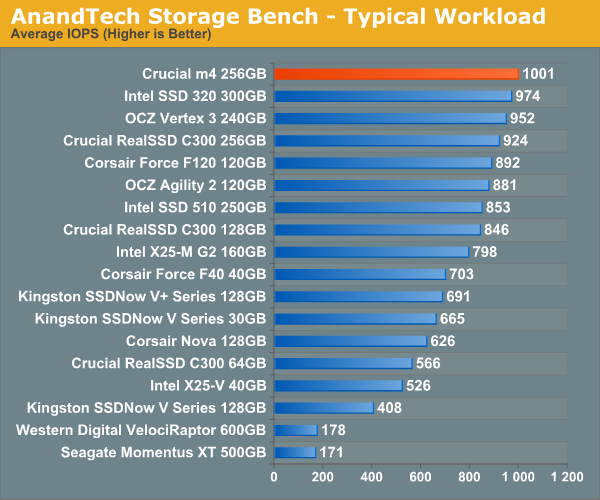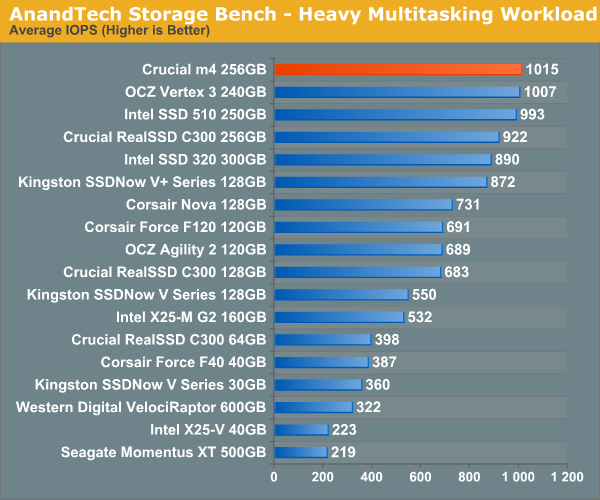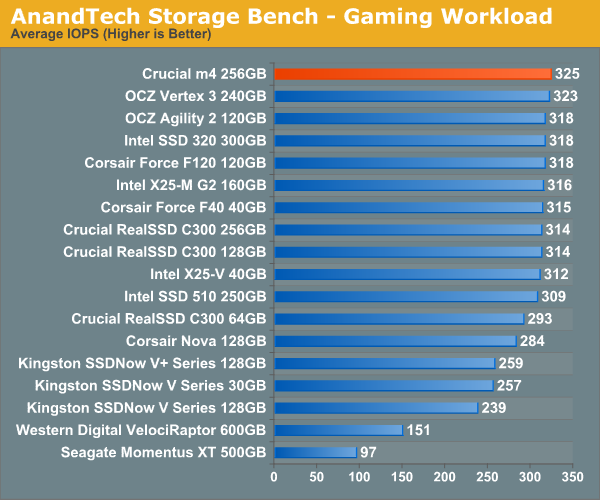The Crucial m4 (Micron C400) SSD Review
by Anand Lal Shimpi on March 31, 2011 3:16 AM ESTAnandTech Storage Bench 2010
To keep things consistent we've also included our older Storage Bench. Note that the old storage test system doesn't have a SATA 6Gbps controller, so we only have 3Gbps results for the 6Gbps drives.
The first in our benchmark suite is a light/typical usage case. The Windows 7 system is loaded with Firefox, Office 2007 and Adobe Reader among other applications. With Firefox we browse web pages like Facebook, AnandTech, Digg and other sites. Outlook is also running and we use it to check emails, create and send a message with a PDF attachment. Adobe Reader is used to view some PDFs. Excel 2007 is used to create a spreadsheet, graphs and save the document. The same goes for Word 2007. We open and step through a presentation in PowerPoint 2007 received as an email attachment before saving it to the desktop. Finally we watch a bit of a Firefly episode in Windows Media Player 11.
There’s some level of multitasking going on here but it’s not unreasonable by any means. Generally the application tasks proceed linearly, with the exception of things like web browsing which may happen in between one of the other tasks.
The recording is played back on all of our drives here today. Remember that we’re isolating disk performance, all we’re doing is playing back every single disk access that happened in that ~5 minute period of usage. The light workload is composed of 37,501 reads and 20,268 writes. Over 30% of the IOs are 4KB, 11% are 16KB, 22% are 32KB and approximately 13% are 64KB in size. Less than 30% of the operations are absolutely sequential in nature. Average queue depth is 6.09 IOs.
The performance results are reported in average I/O Operations per Second (IOPS):

Lighter read-heavy workloads do very well on the m4. Thankfully for Crucial, most user workloads tend to be very read intensive. Over a 3Gbps interface, the m4 is a bit faster than Intel's 320 in our typical workload from 2010.
If there’s a light usage case there’s bound to be a heavy one. In this test we have Microsoft Security Essentials running in the background with real time virus scanning enabled. We also perform a quick scan in the middle of the test. Firefox, Outlook, Excel, Word and Powerpoint are all used the same as they were in the light test. We add Photoshop CS4 to the mix, opening a bunch of 12MP images, editing them, then saving them as highly compressed JPGs for web publishing. Windows 7’s picture viewer is used to view a bunch of pictures on the hard drive. We use 7-zip to create and extract .7z archives. Downloading is also prominently featured in our heavy test; we download large files from the Internet during portions of the benchmark, as well as use uTorrent to grab a couple of torrents. Some of the applications in use are installed during the benchmark, Windows updates are also installed. Towards the end of the test we launch World of Warcraft, play for a few minutes, then delete the folder. This test also takes into account all of the disk accesses that happen while the OS is booting.
The benchmark is 22 minutes long and it consists of 128,895 read operations and 72,411 write operations. Roughly 44% of all IOs were sequential. Approximately 30% of all accesses were 4KB in size, 12% were 16KB in size, 14% were 32KB and 20% were 64KB. Average queue depth was 3.59.

Last year's heavy multitasking workload was also predominantly read heavy. The m4 does very well here again, roughly equaling the performance of OCZ's Vertex 3.
The gaming workload is made up of 75,206 read operations and only 4,592 write operations. Only 20% of the accesses are 4KB in size, nearly 40% are 64KB and 20% are 32KB. A whopping 69% of the IOs are sequential, meaning this is predominantly a sequential read benchmark. The average queue depth is 7.76 IOs.

Gaming performance is good but we're of course bottlenecked by the 3Gbps SATA interface in this test.










103 Comments
View All Comments
Rasterman - Friday, April 1, 2011 - link
LOL wait a year? You are nuts, a year from now there will be totally new products out at all new high prices. Prices come down? Most of these new drives are not even in full production yet and some aren't even released. Regardless upgrading from a G2 level drive to any of these you aren't going to see any difference in real word use, only if you are doing massive file transfers all of the time or can afford to blow money for minimal performance increases (work system) then there is absolutely no point in upgrading speed wise.eamon - Thursday, March 31, 2011 - link
The article states that "I had the same complaint about the C300 if you'll remember from last year. If you're running an OS without TRIM support, then the m4 is a definite pass. Even with TRIM enabled and a sufficiently random workload, you'll want to skip the m4 as well." These statements don't really seem backed up by the data presented.Take the m4-is-bad-without-TRIM idea: If you lack TRIM *and* torture-test your SSD for twenty-minutes of random writes, then you'll see a significant but temporary loss of performance, is what you show. That's not ideal, but really, outside of benchmarking, 20-minutes of random write torture are exceedingly unusual. And you don't show a benchmark with TRIM support enabled (i.e., not just running on an OS with TRIM support, but running on a filesystem and where the filesystem isn't just completely filled up). Does the same performance degradation occur with normal TRIM usage patterns? That seems to be a far more likely usage pattern, but you don't test it.
This makes the second statement seem even less warranted - first of all, you're testing a very unusual access pattern, and you're doing it without a common feature (TRIM) designed to avoid this degradation, and you're not checking how long it takes for performance to recover (after all, if performance quickly recovers after torture testing, then it may well be reasonable to accept the low risk of low performance since the situation will rectify itself anyhow).
I'm not trying to defend the m4 here - and you might be right, but the data sure seems insufficient to draw these rather relevant conclusions. How quickly does the m4 recover, and how does TRIM impact the degradation in the first place?
JNo - Thursday, March 31, 2011 - link
+1I too am not trying to defend the m4 but I think a lot of emphasis is put on sequential performance reads & writes. Whilst I'm sure the everyone will copy/move very large files to their SSD occasionally, the vast majority will still have them as their boot drive where overall system responsiveness (random reads/writes) is still king. It's still a useful metric to know for those who really want to do video editing etc on an SSD but generally over stated.
For most users, like myself, I think the performance benefits of the amazing Vertex 3 will be imperceptible over the m4 99.999% of the time. So the real question, as always, is price - the Vertex 3 does justify a premium but only a small one. Most value-for-money buyers would probably get better real world value from the m4 assuming it is cheaper.
tno - Thursday, March 31, 2011 - link
I think the thing to remember is that this performance drop occurred during a pretty short torture test. But the possibility still exists that if the m4 delays garbage collection till a sequential write comes along, then the possibility could exist that the drive could suffer lots of insults from random writes, drastically decreasing performance, and, because not very many sequential writes are performed, the garbage collection never has a chance to remedy the situation.This is a hypothetical but it's not that far fetched for those of us that focus on using SSDs as OS drives. If you put a small OS drive in a desktop and supplement it with a large mechanical drive, your OS drive might not see a decently long sequential write for some time. Particularly if all your downloads and content generation goes to the mechanical drive.
Anand Lal Shimpi - Thursday, March 31, 2011 - link
For most users, over the course of several months, access patterns can begin to mimic portions of our torture test. I'll be addressing this in a future article but tasks like web browsing, system boot and even application launches are only sequential IOs for less than 50% of the time.I state that I doubt it'll be the case for typical desktop workloads but honestly there's no way to be sure given a short period of testing. Note that every recommended SSD we test ultimately goes into a primary use system and we subject it to a realistic workload for months, noting any issues that do crop up - which eventually gets fed back into our reviews.
Our data shows that in a perfect world, the m4 does quite well in most of the tests. My concerns are two fold:
1) Low max latency during random write operations seems to imply very little gc work is being done during typical random writes.
2) Our torture test shows that delayed garbage collection can result in a pretty poor performance scenario, where the m4 is allowed to to drop a bit lower than I'd like.
How likely is it that you'll encounter this poor performance state?
1) Without TRIM it's very likely. One of the machines I run daily is an OS X system without the TRIM hack enabled. Indilinx, the C300 and even Intel's X25-M both hit this worst case scenario performance level after a few months of use.
2) With TRIM it'll depend entirely based on your workload. Remember that you never TRIM the entire drive like we did (only in the case of a full format). Given a sufficiently random workload without enough consistent sequential writing to bring up performance, I could see things get this bad.
Again my point wasn't to conclude that the m4 was a bad drive, just that these are concerns of mine and I'd rather be cautious about them when recommending something to the public. It's no different than being cautious about recommending the Vertex 3 given unproven reliability and questionable track record.
Take care,
Anand
kmmatney - Thursday, March 31, 2011 - link
So, could someone write a tool that does a huge sequential write to restore performance? Sort of like running the Intel SSD Toolbox and manually doing a TRIM? I could live with that. I'm still running Windows XP at work.bobbozzo - Thursday, March 31, 2011 - link
Just copy a really big file from another drive.bobbozzo - Thursday, March 31, 2011 - link
Or a bunch of not as big files.7Enigma - Friday, April 1, 2011 - link
I'm quite certain I remember there being a program that does this created by an enthusiast way back during the first gen of SSD's.lyeoh - Friday, April 1, 2011 - link
To me I'm actually very happy about the low latency during random write (and read) ops.Can't there be a way to do garbage collection during idle time and not sacrifice latency?
Yes I know that the drive could think it's idle and then start garbage collection just at the very moment when the user finally decides to do something. But if you do the garbage collection at a low intensity, should it affect performance that much? I'm assuming that since the drives are fast they can do a fair bit of garbage collection during idle at say 10-20% speed and not affect the user experience much.
Enterprise drives might be busy all the time and total throughput often matters more than keeping latency in the milliseconds (it's still important but...), so the best time to do garbage collection for those drives would be ASAP.
But that's not true for Desktop drives. Right now as I'm typing in this post, my HDD isn't busy at all. So an SSD could do a fair bit of GC during that long pause. Same for when you are playing a game (after it has loaded the game assets).
It seems silly for Desktop SSDs to do GC during the time a user wants to do something (and presumably wants to get it done as fast as possible).
The Intel SSDs have a max latency of hundreds of milliseconds! That's very human noticeable! Do conventional nonfaulty HDDs even get that slow?